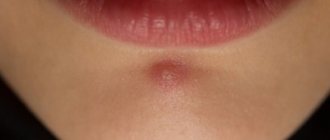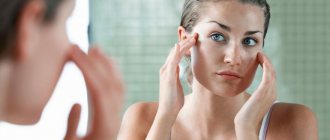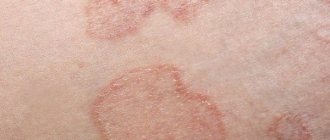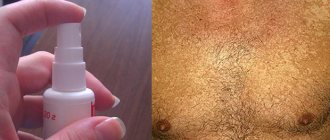Symptoms of pityriasis rosea
Both in childhood and in adulthood the disease occurs in the same way, so the following symptoms of pityriasis rosea can be identified:
- A single large spot appears on the human body, which can reach 10 cm in diameter. Doctors call this spot the maternal spot. Its color varies and can range from pale pink to red. The skin in the affected area becomes dry.
- Itching and burning may bother the patient, but only 50% of patients with pityriasis rosea complain about these sensations. However, a quarter of patients indicate severe itching, which is most often associated with other effects on the dermis, or occurs due to increased emotional lability of the patient.
- The places where the spot is most often located are: chest, back, neck. The disease most often does not affect the feet, hands, or face.
- After a week (maximum 10 days) from the formation of the initial spot, multiple small rashes appear on the body, having an oval or round shape. They are not as large in size as the mother's spot; most often they do not exceed 15 mm in diameter. New spots are clearly visible against the background of unaffected healthy skin.
- A distinctive feature of the secondary spots of lichen Zhiber lies in the peculiarities of their location. They tend to form groups that resemble the outline of a Christmas tree. The spots have clear boundaries along the edges and are slightly flaky in the center.
- Often secondary rashes are located along Langer's lines. This is the name given to the conditional lines on the surface of the skin, which indicate the direction of maximum extensibility of the dermis. Pityriasis rosea selects these places, since it is along their course that bundles of collagen fibers are located.
- The rashes do not appear instantly, they appear in stages with an interval of about 10 days. Before the next group of spots appears on the body, a person may experience malaise, weakness, and sometimes chills. This condition is explained by intoxication of the body.
In no case should you make a diagnosis yourself, focusing on a description of the symptoms of the disease, or by comparing photographs. Some other varieties of lichen are also characterized by the appearance of one reddish spot. People often confuse lichen rosea with lichen planus, which is more dangerous to health. In addition, secondary syphilis, psoriasis, measles, and rubella have a similar clinical picture. Contacting a dermatologist to clarify the diagnosis is mandatory; self-medication of any skin diseases is unacceptable.
Many adults do not experience any symptoms of the disease at all and pay attention to it only because the spots appear. They can itch only after taking a hot shower, or due to stress.
In childhood, the appearance of spots is often accompanied by an increase in body temperature, headaches, rhinitis, and sore throat.
Causes of pityriasis rosea
To date, it has not been established what the true cause of pityriasis rosea appears. Also, the pathogen that causes this disease has not been isolated. Some scientists are of the opinion that Zhiber's lichen may be associated with a herpes infection, namely herpesviruses 6 and 7.
They explain this by saying that before rashes appear on the human body, some patients experience flu-like symptoms. In addition, a seasonal connection with the disease has been established. Its peak occurs in autumn and spring, when there is a drop in temperature, a decrease in immune strength, and an increase in the number of people with colds.
The question of how pityriasis rosea is transmitted also remains open. There is an assumption that the disease can be transmitted by airborne droplets. However, there is still no consensus on whether pityriasis rosea is contagious at all. After all, with a strong immune system, the development of the disease does not occur at all, since the body easily copes with it.
Another theory regarding the cause of pityriasis rosea is based on the fact that this disease is an infectious-allergic reaction. Scientists, as confirmation of this version, cite the fact that patients with pityriasis rosea have a positive reaction to the intradermal administration of streptococcal vaccine.
Proponents of the third theory point out that pityriasis rosea is only a peculiar reaction of the body to hypothermia. They call Zhiber's lichen a skin cold that occurs due to a decrease in immunity.
Finally, the latest theory for the cause of pityriasis rosea considers nervous shock, psychological breakdown, severe stress (symptoms and causes of stress).
Prevention
It is possible to avoid the occurrence of the disease. To do this, you need to strictly adhere to a healthy lifestyle, avoid stressful situations, overheating and hypothermia. Girls should limit themselves to applying cosmetics to their skin. Preserving and maintaining natural beauty is the best way to keep your skin healthy.
Ventilation of rooms, as well as evening walks, should be done daily. It is recommended for a healthy person to change bed linen once a week. For an infected person – at least three times a week. During periods of exacerbation of diseases transmitted by airborne droplets, you should take a course of immunostimulating antiviral drugs and vitamin-mineral complexes.
Infectious, viral and bacterial diseases must be cured completely! The remaining pathogenic microorganisms can become the main cause of lichen! During the course of the disease, under no circumstances should you eat tropical fruits and berries! And also wear tight-fitting synthetic clothing!
Ringworm is indirectly contagious. People with a depleted immune system and an unbalanced mental state succumb to it. To avoid infection, you must carefully follow the above preventive measures. And also avoid the appearance of colds.
Why is pityriasis rosea dangerous? Consequences and complications
Pityriasis rosea is not considered a disease dangerous to human health. It rarely contributes to the development of any complications or consequences, and the spots that the disease leaves behind on the skin will disappear after 1-11 weeks. It is extremely rare that the disease can last for six months.
Complications of the disease are recorded in isolated cases, these may include:
- Development of pyoderma;
- Hidradenitis;
- Ostiofolliculitis;
- Folliculitis;
- Streptococcal impetigo;
- Eczema.
The reasons why this or that complication occurs are: friction of skin areas with pityriasis rosea, excessive washing, improperly administered therapy, hyperhidrosis, the presence of an individual predisposition to allergic reactions.
Disinfection of bed linen
What's the point of cleaning the apartment if the spores remain in your clothes? After carrying out cleaning activities in the room, take care of the bed linen and underwear. Replace everything with clean, washed items. With removed clothes do the following:
- Wash at a temperature of at least 90 degrees.
- Subsequent ironing. A hot iron completely disinfects washed items. This is the most affordable, reliable and safe cleaning method. Ironing clothes kills more than just harmful lichen spores. It can destroy helminth eggs (pinworms).
There is a misconception: lichen spores cannot withstand strong cooling. Naive people begin to simply freeze their underwear, hoping that the action will be correct. This information is false. Some living microorganisms can indeed die at low temperatures, but not spores. The microbial cell forms them in order to survive unfavorable conditions and then continue to reproduce again.
Since lichen can enter your apartment on the paws of a pet, pay due attention to your pet. Wash the coat with an antifungal shampoo. Then disinfect the things your pet has come into contact with.
Diagnosis of pityriasis rosea
If the disease has a typical course, then only a standard examination in a dermatologist’s office is sufficient to make a diagnosis. After the examination, the doctor will prescribe a dermatoscopy to confirm the diagnosis.
When skin rashes persist for more than 6 weeks, it is advisable to perform a skin biopsy followed by histological examination. This makes it possible to exclude parapsoriasis.
If infectious complications occur, the doctor will refer the patient to submit a skin scraping from the source of inflammation, followed by bacterial culture.
To make sure that the symptoms of pityriasis rosea are not hiding pityriasis versicolor, it is possible to perform a fluorescent diagnosis and scrape the skin to detect fungi in it. The RPR test for syphilis is performed to exclude secondary syphilis.
Final tips
If there is a person or animal in your home who has contracted herpes zoster, daily thorough cleaning of the room will not be enough. You need to somehow protect yourself. Even a strong immune system is powerless against viral or fungal diseases transmitted by contact. Therefore, follow the rules in relation to a sick roommate:
- For lichen lesions on the scalp, antifungal shampoo or soap should be used. Moreover, hair washing is carried out daily.
- Bathing takes place with the addition of selenium-containing products. Why should selenium be present in the composition? This element is indispensable for lichen lesions: it kills its spores and is harmless to humans.
- You cannot use the patient's personal belongings.
- If there is excessive peeling of the scalp, wear protective bandages. If you volunteer to help a patient, treat your hands with antiseptic after the manipulations. Worn bandages are burned.
Treating an apartment against lichen spores will require considerable effort. Constant disinfection, careful communication with the patient, and adequate treatment will help clear your home of infection once and for all. Diseases caused by herpes zoster vary in severity of treatment and lengthy therapy. It is better to take preventive measures in time and prevent infection of yourself and others. In any case, the premises will have to be disinfected, since lichen spores live for many years. It is not a fact that during this time you will not pick up a dangerous “sleeping” pathogen.
Answers to popular questions:
- How long do people suffer from pityriasis rosea? The disease can last from 1 week to 1 month. In isolated cases, pityriasis rosea can bother a person for more than 5 months.
- Could I get pityriasis rosea again in the future? Recurrence of pityriasis rosea is possible, however, this is quite rare. In most cases, the human body develops a strong immunity to the disease.
- Is it possible to get infected with pityriasis rosea from domestic or stray animals (cats, dogs, etc.)? The only pet that can get pityriasis rosea is a pig. However, infection from this animal, like from any other, is impossible.
- Is it necessary to smear the spots with rosacea with something? Often, having contracted pityriasis rosea, people try to speed up recovery by applying various ointments and compositions to the spots (for example, boric or acetic acid, iodine, zinc or sulfur ointment, antimycotic ointments, sea buckthorn oil, etc.). However, there is not a single scientific evidence that these products are in any way capable of influencing the recovery of the skin from the disease.
- Can it be transmitted from person to person or through sexual contact? Official medicine claims that pityriasis rosea is not a contagious disease and its transmission from person to person or through sexual contact is impossible. However, science knows cases when the whole family fell ill with Zhiber at the same time. If pityriasis rosea develops in a child, then this is not a contraindication for him to attend an educational institution.
- Is it possible to sunbathe or relax at the seaside if I get pityriasis rosea? You can sunbathe and relax at seaside resorts, but you need to try not to get sunburned at this time. The fact is that burns from ultraviolet rays can increase skin itching. In addition, it is always worth remembering that excessive sun exposure increases the risk of developing skin cancer. (read also: Stages, symptoms, signs and treatment of skin cancer)
- Can I take a shower/bath if I have pityriasis rosea? You can take a bath or shower without any worries. However, if the patient is bothered by itching, then too hot water should be avoided.
Treatment
There is no specific treatment; therapy is required only in atypical cases. The goal of treatment is to strengthen the immune system, as well as symptomatic therapy aimed at alleviating the symptoms of the disease.
It is necessary to follow a hypoallergenic diet.
Exclude:
- citruses;
- fruits: pineapples, red apples, blueberries, grapes, plums, raspberries, etc.;
- seasonings, spices;
- dairy products, eggs, cheeses;
- sparkling water;
- honey, nuts;
- alcohol;
- products with dyes;
- chocolate.
You might be interested! What are the first signs of lichen infection in humans?
Limit:
- cereals;
- fatty meats;
- bananas, peaches, watermelon;
- legumes;
- potato.
Include in your diet:
- lean meats;
- dairy products;
- liver, kidneys;
- mineral water;
- olive oil;
- oat and rice cereals.
The diet is followed for a month. Next, enter one product at a time from the list of excluded products. It is worth noting that if the cause of the disease is an allergic reaction, then the product that caused the allergy must be excluded, even if it is in foods allowed in the diet.
How to treat pityriasis rosea in atypical and complicated forms:
- broad-spectrum antibiotics (ceftriaxone, oletethrin, amoxiclav). They have a bactericidal effect, that is, they kill bacteria. They contain auxiliary substances that help activate cells of the immune system;
- antihistamines (suprastin, zodak). In other words, antiallergic. They prevent the effects of histamine on the body, preventing adverse effects from developing;
- antiviral. In particular, acyclovir is taken, as it affects all types of herpes. With prolonged use, patients develop immunity to the virus;
- antipyretics at elevated temperatures (paracetamol);
- corticosteroid ointments (hydrocortisone, belogent). Hormonal ointments have an anti-inflammatory effect, removing swelling from the affected areas;
- vitamins (A, C, PP, group B). Strengthen the body and immunity;
- aqueous shaken suspensions (zinc oxide, starch, talc). They have a drying effect on the affected areas.
All medications and doses are prescribed strictly as prescribed by a dermatovenerologist. Self-treatment can lead to complications. Frequent water procedures should be excluded, as they lead to the spread of infection throughout the body, and physical activity due to increased sweating.











